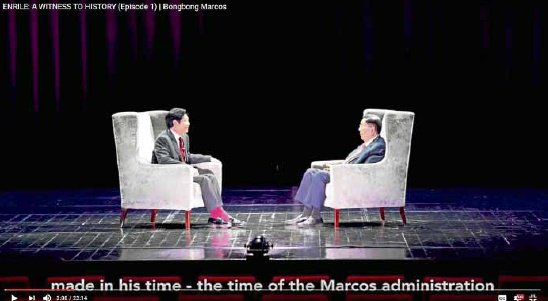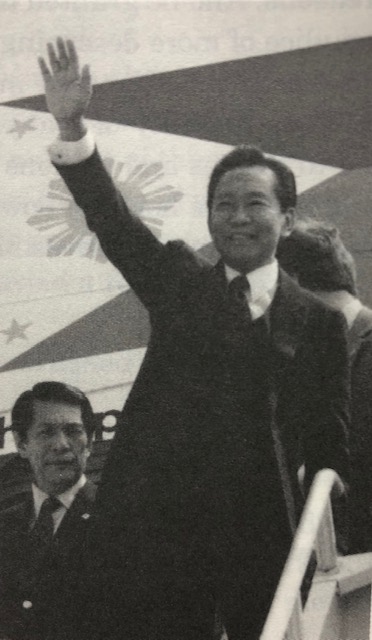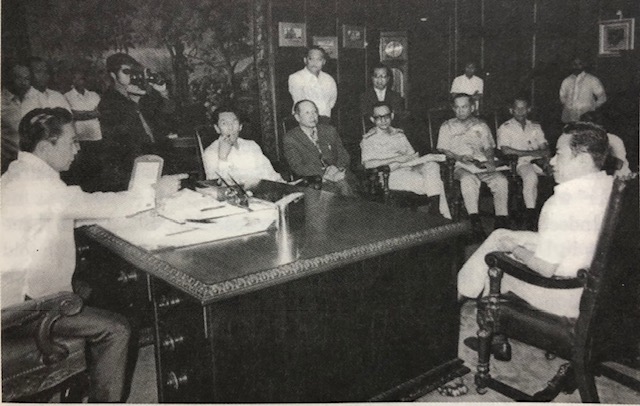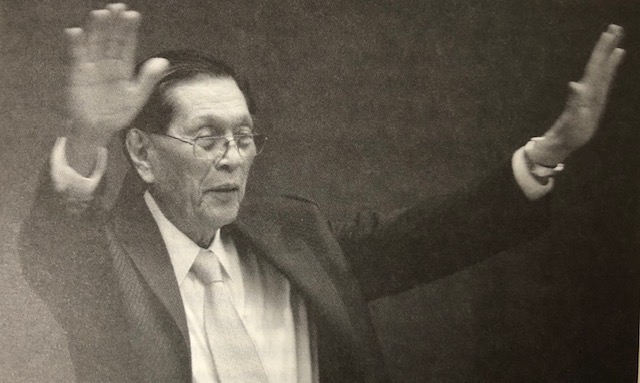There are at least three instances in this decade where former Senate President and Defense Minister Juan Ponce Enrile reversed a story he said before or encountered adamant witnesses who tell a different version.
The most disturbing occurred last week, in an ‘interview” with benefactor Ferdinand Marcos’ son, where Enrile claimed no one was arrested during martial law “simply because he criticized Marcos.”

The children of the late Senator Jose “Pepe’ Diokno released a lengthy letter calling Enrile’s statement “patently false” and meant “to cleanse shameful acts, records, and reputations.”
The timing was suspect. The interview by former senator Ferdinand “Bongbong” Marcos, Jr. was released on the 46th anniversary of Marcos’ declaration of martial law.
The first of what appears to be several installments on YouTube also aired amid numerous attempts to draw parallelisms between Marcos’ and incumbent President Duterte’s leadership styles.
Enrile downplayed the imprisonment of Marcos critics. He said the detainees were “inconvenienced for a while, but all were released.”
Diokno, the children countered, stayed in jail for two years because Father refused to sign a pledge of allegiance—basically promising to kowtow to the dictatorship—Enrile wanted him to sign.
Out of the woodwork
More martial law detainees surfaced.
Former human rights commissioner Etta Rosales displayed a close-up of her mug shot. Ex-party-list representative Satur Ocampo recalled how he endured electrocution from forehead to genitals.
Erstwhile senator Aquilino “Nene” Pimentel Jr. said he was jailed four times and ousted from elected office twice while colleague Rene Saguisag accused Marcos of aborting the “natural evolution of leadership” by incarcerating his political foes.
Even Malacañang, despite President Duterte’s unabashed adoration of Marcos, washed its hands through spokesperson Harry Roque.
In a news conference, Roque said court decisions affirming human rights violations during martial law and a subsequent law providing monetary compensation for victims should put the issue to rest.
Enrile made two more denials in recent memory. He claimed in his memoir released in 2012 that the botched ambush hatched against him by communists, that Marcos later used to justify martial law, indeed happened. This despite his earlier pronouncement that the ambush was staged.
Another time, Enrile belied critics’ assertions he begged Jaime Cardinal Sin to send help as soldiers sent by Marcos began to envelop the areas surrounding Camp Crame. This was during the initial hours of Edsa 1986 when Enrile and then constabulary chief Fidel Ramos were holed up in the camp after turning against the dictator.
Shining star
To long-time observers, Enrile’s flip-flopping about Marcos and martial law is not unexpected. It is very understandable.

After all, Enrile’s swift ascent in government service and his survival in the brutal world of Philippine politics might not happen had Marcos not taken him under his wing.
Marcos’ trust also helped Enrile endure the supposed attempts of First Lady Imelda and the dictator’s right-hand man Armed Forces of the Philippines (AFP) chief of staff Gen. Fabian Ver to ease Enrile out of the martial law power circle.
Enrile’s memoir (nolisoli.ph used uncontested portions of the subject’s memoir to establish his ties with Ferdinand Marcos) traces his entry to Marcos’ posse around 1964—a year before the dictator’s legitimate presidential win.
Then Senate President Marcos, a fresh turncoat from the Liberal Party, asked lawyer Enrile to help his campaign in Cagayan province by snatching the province’s party votes from presidential hopeful and NP stalwart Vice President Emmanuel Pelaez.
Enrile eventually joined Marcos’ campaign staff, became the conduit with “influential relatives, friends, and future business cronies,” made sure Marcos’ income tax returns were in order and even filed Marcos’ certificate of candidacy for him.
Enrile also represented Marcos in court when the Board of Censors (allegedly upon orders of reelectionist President Diosdado Macapagal) blocked the public screening of Marcos’ campaign flick disguised as bio-pic Iginuhit ng Tadhana.
Rewards for Enrile came as a torrent after Marcos’ victory. He was made justice undersecretary in charge of the Bureau of Internal Revenue, Bureau of Customs and assorted other finance-related offices.
And after finding a way to skirt congressional scrutiny in constructing Imelda’s pet project —the Cultural Center of the Philippines, Enrile said he was named acting finance secretary with the concurrent post of customs commissioner.
Martial law beginnings
Days after Marcos won a second term, Enrile said Marcos asked him “to study his powers under the commander-in-chief provisions of the Constitution,” noting the boss mentioned the “escalation of violence and disorder in the country.” Marcos made him defense secretary afterward.
Marcos included Enrile in the 1971 mid-term senatorial lineup of the Nacionalista Party. Enrile blamed his loss on the Plaza Miranda bombing that left Liberal Party members and supporters either dead or mangled.
Enrile resigned from his post. Before setting off, he submitted to Marcos several confidential documents including a draft of the proclamation to declare martial law. His hiatus was cut short after Marcos offered him anew the defense portfolio, topped with the post of deputy commander-in-chief of the AFP.
Before martial law was declared, Marcos not only faced strong opposition from the Liberal Party that was critical of his policies. There was also growing insurgency in Mindanao, student unrest, the rise in private armies and the growing leftist insurgency.
In early September 1972, Liberal Party senator Ninoy Aquino delivered a privilege speech exposing “Oplan: Sagittarius” that would place all towns and cities around Manila under control of the Philippine Constabulary.
Days later, as if to confirm Ninoy’s fears, Marcos announced he was “studying” the “use of extraordinary presidential powers” to control the communist threat.
Marcos also accused Liberal Party senators, particularly Ninoy, of conniving with Jose Maria Sison of the Communist Party of the Philippines. Marcos warned them of “a revolutionary situation which would compel the use by the President of his emergency powers.”
Enrile said the controversial ambush he survived took place shortly after. In his memoir, he noted that Marcos used the incident as his reason to declare martial law, although the blueprint Enrile drafted was completed years before.

Enrile explains his exit
Enrile’s even broader powers during martial law are well-documented. As Marcos fell sick, Enrile admitted he had secret meetings with disgruntled military officers expressing dissatisfaction with the dictator.
Enrile openly blamed Imelda and Ver for distancing the ailing Marcos from reality and withholding information as they tried to gain control of the government.
Enrile’s rationalization of his participation in Edsa 1986 goes:
“My decision…was not the result of an impulsive and emotional outburst. It was not the product of reckless and irrational madness. Neither was it impelled by pressure of any kind.
“I mulled my decision…for many years. It was the result of frustrations and deep reflection and intense soul-searching over a long period of time.
“It was also the ultimate resolution of a moral dilemma that burdened me for years—my loyalty and duty, on the one hand, to a man who was more than a dear friend to me and my loyalty and duty, on the other hand, to the country and people that I was sworn to serve.”
Enrile admitted that leaving Marcos “could lead to my destruction and final oblivion…I had no more choice. Either I took the lives of my foe and survived, or my foes took my life, and I perished.”
Cory! Cory!
Pundits will agree with Enrile’s inclusion in President Corazon Aquino’s administration was shaky from the very start. It was clearly an accommodation, an act of “utang na loob” for helping hasten Marcos’ exit.
Enrile retained the defense portfolio and was poised to become a major player but the glory was short-lived.
While Cory initially “appeared pleasant and attentive to me,” Enrile blamed Cabinet men whose aloofness morphed into “silent hostility.”
Cory’s men could also not be blamed for feeling this way, of course. Enrile, after all, will always be regarded as the “architect of martial law’ and the warden of political detainees that included many friends and loved ones.
It also did not help that Enrile also stood accused of benefitting from Marcos’ largesse. To this day, questions remain about the origins of some of his assets.
The death blow came when Marcos loyalists gathered at the Manila Hotel to install Marcos’ 1986 snap election running mage Arturo Tolentino as president.
Defense Secretary Enrile ordered military officers and soldiers linked to the incident to do 30 push-ups—a penalty that did not sit well with Cory’s men. Enrile said had he given in to critics to give a harsher penalty, it would have only driven the soldiers to “open revolt.”
It was downhill from there. Enrile left the Aquino Cabinet and Cory made known her contempt. Enrile joined an opposition party composed predominantly of personalities linked to Marcos. In 1987, the first national election after martial law, Enrile and San Juan mayor Joseph Estrada barely made it to the Senate.

Senator Enrile
The upper chamber, however, provided little relief. Among fellow senators were those “inconvenienced” in one way or another by martial law like Pimentel and Saguisag. Also Tito Guingona, Orly Mercado, Wigberto Tañada, Ernesto Maceda, Ninoy’s brother Butz Aquino and Heherson Alvarez who recently challenged Enrile to a debate on martial law.
Enrile again figured in the news after he was linked to the 1989 attempt to oust Cory. It was the bloodiest among several staged by the Reform the Armed Forces Movement (RAM) that considered Enrile as its adoptive father.
Despite his position, Enrile was imprisoned by then Justice Secretary Franklin Drilon who charged him with “rebellion complexed with murder.” Enrile posted bail, the case fizzled out and he kept his head down after that.
Enrile won a congressional seat when fellow Edsa hero Fidel Ramos became president in 1992. He rejoined the Senate in 1995 amid accusations he masterminded the so-called Oplan: Dagdag-Bawas that shaved votes from some rivals and transferred to him.
Enrile ran for president in 1998 but failed. He made a comeback in the Senate in 2004 and won again in 2010.
Enrile’s stint as the presiding officer in the 2012 impeachment trial of Chief Justice Renato Corona was a shining moment. His star dimmed quickly, however, when he was listed among those allegedly involved in the multi-billion pork barrel scam of businesswoman Janet Napoles.
Enrile was detained in Camp Crame and later released on “judicial compassion” given his old age and voluntary surrender.
Again Enrile kept a low profile, only venturing out in the society pages when he and wife Cristina celebrated their 60th wedding anniversary last year.
Narrating his version…out of guilt?

For Enrile to oblige Bongbong an interview that would relive unpleasant martial law memories would seem unnecessary, if not uncalled for. There are those who were not surprised, however.
They consider it Enrile’s atonement of sorts for joining Edsa 1986, an admission of a grave miscalculation. Could that be his motivation?
Enrile’s guilt over the decision to leave his benefactor is evident in his memoir. Enrile did not purposely want to transfer to Cory’s camp but circumstances at that time made it a convenient option. And it was a time when his life was likely under threat from furious loyalists.
Looking back at events after Edsa 1986, Enrile being a Marcos boy obviously worked against him. And we do not discount that Enrile considered himself more capable than those Cory listened to.
After all, what did they know about governance when they were locked away in military camps? Or killing time somewhere in America? Forcibly retired after Congress was locked up? Or happily living quotidian lives before Edsa?
That Enrile suffered another strike in the hands of President Noynoy Aquino’s subordinates in 2013 only worsened whatever ill feelings he already had with Cory’s boys.
Enrile at the time was still riding on his revived popularity after his performance as the presiding officer in the Corona impeachment trial. What followed months after that was the nightmare of his inclusion among lawmakers who pocketed millions in kickbacks from the pork barrel scam.
Is it possible Enrile considered that a betrayal after delivering Corona’s conviction that Noynoy wanted so badly?
This is in no way a defense of Enrile. We do not disagree that he contributed to the Marcos family’s efforts at revising the martial law story. Hence, the possibility that the martial law story told to Bongbong is about self-preservation.
Because what if Bongbong gets his wish and ascends to the second highest position in the land? Better to be friends than enemies.
This speculation makes the invitation from Bongbong easy to accept. A chance to retell history, get back at his oppressors, redeem himself publicly—no matter how belated—for turning against his Pygmalion and secure a rightful place in case the old family friends get lucky.
Header photo courtesy of Inquirer.net
Read more:
Stop saying that artists thrived during martial law
“Malakas at Maganda” as propaganda: Deceitful art during Martial Law
#NeverForget: Essential reads on remembering Martial Law
Read more by Cathy Cañares Yamsuan:
A martial law childhood spent among Marcos loyalists
We need mature leadership, not nonchalant rambling, Mr. President
Why is the Vatican still silent on the issue of abusive priests?
Writer: CATHY CAÑARES YAMSUAN




